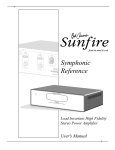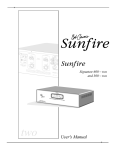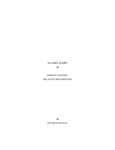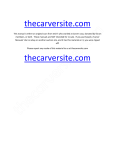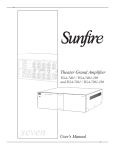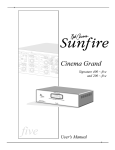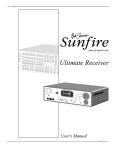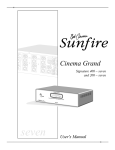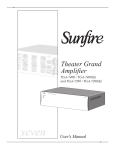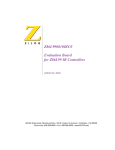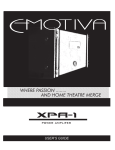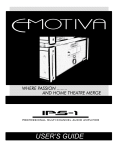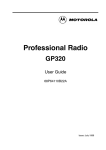Download Sunfire Symphonic Reference High Fidelity Control Center and Preamplifier Stereo Amplifier User Manual
Transcript
Symphonic Reference High Fidelity Control Center and Preamplifier SAFETY Safety Instructions 1. Read Instructions -– All the safety and operation instructions should be read before the SunÞre Component is operated. 2. Retain Instructions — The safety and operating instructions should be kept for future reference. 3. Heed Warnings — All warnings on the Component and in these operating instructions should be followed. 4. Follow Instructions — All operating and other instructions should be followed. 5. Water and Moisture — The Component should not be used near water - for example, near a bathtub, washbowl, kitchen sink, laundry tub, in a wet basement, or near a swimming pool, etc. 6. Ventilation — The Component should be situated so that its location or position does not interfere with its proper ventilation. For example, the Component should not be situated on a bed, sofa, rug, or similar surface that may block any ventilation openings; or placed in a built-in installation such as a bookcase, cabinet, or closed equipment rack that may impede the ßow of air through ventilation openings. 8. Power Sources — The Component should be connected to a power supply only of the type described in these operation instructions or as marked on the Component. 9. Power Cord Protection — Powersupply cords should be routed so that they are not likely to be walked upon or pinched by items placed upon or against them, paying particular attention to cords at plugs, convenience receptacles, and the point where they exit the Component. 10. Cleaning — The Component should be cleaned only as recommended in this manual. 11. Non-use Periods—The power cord of the Component should be unplugged from the outlet when unused for a long period of time. 12. Object and Liquid Entry — Care should be taken so that objects do not fall into and liquids are not spilled into the inside of the Component. 13. Damage Requiring Service — The Component should be serviced only by qualiÞed service personnel when: A. The power-supply cord or the plug has been damaged; or B. Objects have fallen, or liquid has spilled into the Component; or C. The Component has been exposed to rain; or D. The Component does not appear to operate normally or exhibits a marked change in performance; or E. The Component has been dropped, or its cabinet damaged. 14. Servicing — The user should not attempt to service the Component beyond those means described in this operating manual. All other servicing should be referred to qualiÞed service personnel. 7. Heat — The Component should be situated away from heat sources such as radiators, or other devices which produce heat. 2 User's Manual SAFETY 15. To prevent electric shock, do not use this polarized plug with an extension cord, receptacle or other outlet unless the blades can be fully inserted to prevent blade exposure. Pour préevenir les chocs électriques ne pas utiliser cette Þche polariseé avec un prolongateur, un prise de courant ou une autre sortie de courant, sauf si les lames peuvent être insérées à fond sans laisser aucune parIIIe à découvert. 16. Grounding or Polarization — Precautions should be taken so that the grounding or polarization means of the Component is not defeated. This apparatus does not exceed the Class A/Class B (whichever is applicable) limits for radio noise emissions from digital apparatus as set out in the radio interference regulations of the Canadian Department of Communications. ATTENTION — Le présent appareil numérique n'émet pas de bruits radioélectriques dépassant las limites applicables aux appareils numériques de class A/de class B (selon le cas) prescrites dans le règlement sur le brouillage radioélectrique édicté par les ministere des communications du Canada. WARNING – TO REDUCE THE RISK OF FIRE OR ELECTRIC SHOCK, DO NOT EXPOSE THIS APPLIANCE TO RAIN OR MOISTURE. CAUTION: TO PREVENT ELECTRIC SHOCK, MATCH WIDE BLADE OF PLUG TO WIDE SLOT, FULLY INSERT. ATTENTION: POUR ÉVITER LES CHOCS ÉLECTRIQUES, INTRODUIRE LA LAME LA PLUS LARGE DE LA FICHE DANS LA BORNE CORRESPONDANTE DE LA PRISE ET POUSSER JUSQU’AU FOND. Contents Safety Instructions................................... 2-3 Chapter 1: Introduction ...............................4 Unpacking and List of Features .................4 Front Panel .................................................5 Rear Panel..................................................6 Installation ..................................................7 Remote Control ..........................................7 Chapter 2: System ConÞgurations .............8 Appendix: Troubleshooting Guide .............................13 SpeciÞcations ...........................................14 Limited Warranty ......................................15 Service Assistance ...................................15 User's Manual Please read the Safety Instructions carefully before connecting and using your SunÞre PreampliÞer. Chapter 1 is a general introduction to the features, details and installation of the preampliÞer. Chapter 2 shows options for connecting your source equipment and power ampliÞer. The Appendix shows some additional information, including a troubleshooting guide, the Warranty, and service assistance details To Þnd out more about this and other SunÞre products, please visit our website: www.sunÞre.com 3 CHAPTER 1 Introduction Unpacking Your SunÞre PreampliÞer should reach you in perfect condition. If you do notice any shipping damage, please contact your SunÞre Dealer immediately. Dear Friend, Thank you for purchasing my SunÞre Symphonic Reference PreampliÞer. I hope that you enjoy it and the music it makes as much as I have enjoyed creating it for you. Gently lift out the unit and remove all the packing material and accessories. It is important to save all the packing materials and the box in case your preampliÞer ever needs to be moved or shipped for repair. Make sure that you keep your sales receipt. It is the only way to establish the duration of your Limited Warranty and it may come in useful for insurance purposes. Please take a moment to Þll out and mail the SunÞre Customer Response card. Also read the serial number located on the rear panel and record it here: Serial #: ___________________________ Purchased at: ___________________________ ___________________________ ___________________________ ___________________________ Features • • • • • Pure Stereo PreampliÞer Five line-level L/R inputs Full range line-level L/R output High-pass line-level L/R output Low noise Phono section with Moving Magnet and Moving Coil cartridge selector switch • Tape Monitor loop • External Processor loop • Direct bypass mode • Treble and Bass Tone controls • Balance control • Motorized Volume control with remote control • Front panel IR window and LED • Mute switch • Mono switch • 1/4" Headphones jack • Illuminated input switches • Indicator LEDs • Two rear panel IR ports • 12 VDC trigger for turning on SunÞre ampliÞers • IEC removable power cord • Three unswitched convenience outlets • High quality styling and Þnish • 17 inches wide • Remote control with matching styling and Þnish Date: _______________________ 4 User's Manual CHAPTER 1 Front Panel Features 1 12 2 11 10 1. Power This turns the preampliÞer on or off. It is a non-latching momentary button. 2. Input Selectors Press one of these illuminated buttons to select the source you want to listen to. The selected button will change color. 3. Infrared Remote Control Window This window should be clean and free from obstruction. The LED will light when a remote control infrared command is received. 4. Volume Rotate this control clockwise to increase the volume. The control is motorized, and will rotate when the remote control is used to adjust the volume. Make sure its rotation is not restricted. 5. Balance Rotate this to the left or right until the soundstage appears equally balanced. User's Manual 2 9 8 7 6 6. Tone These controls apply a cut or a boost to the Bass and Treble frequency ranges. In the center position, there is no effect on the audio signal. The controls work independently of each other. 7. Direct This bypasses the Tone controls and allows the shortest signal path through the preampliÞer. Use this to obtain the cleanest direct sound through your system. 8. External Processor Press this to route the preampliÞer signals through an external processor or graphic equalizer. 9. Tape Monitor Press this to engage the Tape Monitor Loop. This is used for Tape players such as three-head designs, which allow you to monitor the actual sound being recorded. For example, if you wanted to record a CD, you would select the CD input and then press this Tape button. When you set your 3 4 6 5 Tape player to record, you will then hear the CD sound as it will appear on the tape. You will also hear any adjustments you make with your Tape player's controls, such as record level, bias or record balance. Note: The rear panel Tape output, and External Processor output, are not affected by the preampliÞer's Volume, Balance, Mute, Mono or Tone controls. 10. Mono Press this to listen to Mono sources. The left and right signal paths are joined, so Mono sources can be heard from both speakers. When engaged, a correctly set up system should produce a strong center image directly between the two speakers. 11. Mute This turns off the sound. Press it again to turn the sound back on. 12. Headphones Use this jack to connect a pair of your favorite headphones. 5 CHAPTER 1 Rear Panel Features 1 2 3 1. Ground Screw This is commonly used for the ground connection wire of a turntable, to prevent any hum in your speakers. It is tied to the chassis ground, and may be used as needed. Note: It is not necessary or desirable to connect this to an electrical ground. 2. Phono Selector If you are using a turntable with a low output Moving Coil cartridge, set this switch to the MC position. Use the MM position if it has a high output Moving Magnet cartridge. This will correctly set the gain of the Phono circuit. 3. Audio Inputs Any standard audio component with a line level output can be connected to CD, Tuner, Aux1 or Aux2. Only a turntable can be connected to the Phono input. Set the Phono Selector Switch correctly to match your type of cartridge before using the Phono input. 4. Tape In and Out Tape In connects to the output (play) of a Tape player, and Tape Out connects to the input (record). 6 4 5 6 7 The Tape Outputs are unaffected by the preampliÞer volume or tone controls. 5. External Processor If you have an external processor or graphic equalizer, it should be connected here. 6. Outputs These line-level RCA outputs connect to the inputs of your power ampliÞer. The Main outputs cover the main frequency range between 20 Hz and 20 kHz. The High-Pass outputs are rolled off below 80 Hz. 7. 12 VDC Trigger This 1/8” mini-jack supplies +12 VDC whenever the preampliÞer is turned on. It can be used to automatically turn on SunÞre ampliÞers for example. Do not exceed a current draw of 500 mA. 8. IR In and Out These are used in custom installations to control the preampliÞer from a remote location. The jacks accept 1/8” mono mini-plugs from standard remote control IR equipment, such as those made by Xantech and other companies. Place remote sensors in a preferred location in your main room. 8 8 9 10 9. IEC Linecord Socket The preampliÞer comes with a detachable linecord which connects here. Plug the linecord into an AC wall socket or power strip which is correctly conÞgured with the voltage speciÞed for your model. 10. AC Outlets These three AC outlets allow you to supply power to the other components in your system. These unswitched outlets are live whenever the preampliÞer line cord is plugged into a live wall socket or power strip. They are live even if the preampliÞer is turned off. Take care that the preampliÞer is unplugged or turned off at the AC wall socket or supply, before connecting any linecords here. Make sure the power consumption of all your components does not exceed 1000 Watts. Do not plug a power ampliÞer into these outlets. User's Manual CHAPTER 1 Installation Observe the following precautions when choosing a location for your preampliÞer: • Do not cover any of the ventilation slots. • Do not place directly on top of a power ampliÞer. • • to prevent any hum or interference heard in the speakers. • Choose reliable hookup cables. They should be fully shielded and as short as possible. • Some patch cords can be a very tight Þt and there is usually a preferred method of getting them off. Some have to be removed with a twisting action. Be gentle or you may damage the jacks of your preampliÞer, or other components. Protect it from prolonged exposure to direct sunlight and other direct sources of heat, such as heating vents and radiators. Do not expose the unit to rain or moisture. If ßuid or a foreign object should enter the unit, immediately turn off the power and contact your SunÞre Dealer. • Avoid excessive exposure to extreme cold or dust. • Do not place heavy objects on top of the unit. AC Power Considerations Ensure that the unit is plugged into an outlet capable of supplying the correct voltage speciÞed for your model. Care If you need to clean the front surface, Þrst turn off the power and then use a dry cloth, rubbing with the grain. Be careful not to scratch the Þnish. • • Remote Control POWER VOLUME MUTE CD Some audiophile cables should be hooked up in one direction, these are usually marked with arrows. It is usual for the right channel patch cord plugs to be red and the left channel connections to be white, grey or black. 12 VDC Trigger The preampliÞer's Trigger terminal supplies 12 VDC whenever the preampliÞer is turned on. This can be used to turn on SunÞre power ampliÞers or other equipment with a 12 V trigger input. Use all standard safety precautions and make sure all the equipment is disconnected before making any connections. STEREO/ MONO TUNER TAPE AUX1 PHONO AUX2 TAPE EXTERNAL SOURCE MONITOR PROCESSOR DIRECT Symphonic Reference Preamplifier Remote Control Batteries Use a small Phillips screwdriver and undo the rear cover of the remote to change the batteries. Connection Tips Functions Before setting up your new system, please consider the following : Most functions of the preampliÞer can be operated by the remote control, except for Tone and Balance. Always make sure that your components are all turned OFF, or unplugged before making or changing any connections. • Whenever possible, route the power cords away from the signal cables or speaker wires User's Manual You can connect an external IR receiver to the preampliÞer's rear IR port. This will allow you to operate the preampliÞer from a remote location. Place the preampliÞer or any external Infrared receivers in a place where there is a direct line of sight from your listening position. 7 CHAPTER 2 System ConÞgurations The following pages show some typical connections that you might make in your installation. They show how the inputs and outputs of the preampliÞer are connected to various audio components. Input connections Analog audio signals From: CD Player audio outputs To: PreampliÞer CD L/R audio inputs When the CD input is selected from the front panel or the remote control, the CD’s audio will play in your system. The CD player's AC power cord can be plugged into the preampliÞer's convenience outlets if required. The CD, Tuner, Aux 1, Aux 2 and Tape inputs will accept audio signals from any standard line-level source. Use the left and right analog outputs of your player. The preampliÞer will not decode digital signals. 8 User's Manual CHAPTER 2 Turntable Connections Ground wire From: Turntable chassis ground To: PreampliÞer chassis ground connector Phono-level audio signals From: Turntable L/R audio outputs To: PreampliÞer Phono L/R audio inputs Only connect a Turntable to the PHONO input. In most cases, you should also connect the ground wire to reduce any hum through your speakers. The Phono input is designed for Moving Magnet (MM) cartridges and Moving Coil (MC) cartridges. To avoid overload, DO NOT connect CD players or other line-level sources to this input. User's Manual Set the Phono selector switch to either MM or MC depending on the type of cartridge you have. Do this before you turn on the preampliÞer. If you have a low output Moving Coil cartridge, set the switch to MC. If you have a high output Moving Magnet cartridge, set it to MM. If you are not sure which type of cartridge you have, try MM Þrst, and do a listening test. If the noise level is high, try setting the switch to MC. 9 CHAPTER 2 Tape Player Connections Play Record Analog audio signals (play) From: Tape player audio outputs To: Preamp Tape L/R audio inputs Analog audio signals (record) From: Preamp Tape L/R audio outputs To: Tape Player L/R audio input Connect your Tape player’s analog outputs to the preampliÞer's TAPE inputs. Connect the Tape player's inputs to the preampliÞer's TAPE outputs. The Tape player can record the audio from whichever source is selected. Note that it will record the original signals, unaffected by the preampliÞer's Tone, Balance, Volume or any external processing. Press the front panel Tape Monitor switch if you have a three-head player. This will engage the Tape Monitor loop, and allow you to listen to the exact sounds as they are recorded. 10 User's Manual CHAPTER 2 External Processor Connections Analog audio signals From: External Processor's audio outputs To: Preamp External Processor L/R audio inputs Analog audio signals From: Preamp's External Processor L/R audio outputs To: External Processor's L/R audio input The preampliÞer audio signals can be passed through an external processor or graphic equalizer. The signals going into your external processor are not affected by the preampliÞer's volume, balance or Tone controls. Take care to exercise moderation with your external processor's controls. Too much gain may overload the preampliÞer circuits, causing distortion. User's Manual 11 CHAPTER 2 Output Connections Line-level audio signals From: PreampliÞer main outputs To: AmpliÞer line-level inputs 12 VDC Trigger voltage From: PreampliÞer 12 VDC trigger outputs To: AmpliÞer 12 VDC trigger inputs The preampliÞer's line-level Main audio outputs can be connected to a power ampliÞer as shown. This example shows the matching SunÞre Symphonic Reference power ampliÞer. The 12 VDC connection can be used to turn the ampliÞer on when the preamp turns on. 12 NOTE: As an alternative, you could connect the preampliÞer's HighPass outputs to the ampliÞer, and connect the preampliÞer's Main outputs to a Powered Subwoofer. In this way, the main speakers can play the range above 80 Hz, and the subwoofer can play the low range. Set your subwoofer's crossover point at 80 Hz. This system is beneÞcial if you have small mini monitor type speakers, with weak bass response. User's Manual APPENDIX Troubleshooting Guide Make sure that they are disconnected where they Þrst enter the room, so they are making no connection to the preampliÞer or the TV, or any other component. If the hum is caused by the cable TV line, then you will need a “ground loop isolator.” This is an inexpensive device Þtted in line with the coaxial cable feed. Contact your cable company or your SunÞre Dealer for assistance. The SunÞre PreampliÞer is expertly designed and built to provide years of trouble-free performance. Most problems that occur can usually be solved by checking your setup or making sure that the audio and video components connected to the processor are on and fully operational. The following information will help you deal with common setup problems you may experience during normal use of your unit. If the problems still persist, please contact your SunÞre Dealer for assistance. No sound from one or more speakers • Speaker cables may have come undone. Turn off your system and check the cables, and tighten the ampliÞer and speaker binding posts. • Broken audio cable. • The balance level is low for the channel concerned. • The Mute switch is on. A Hum is heard in your speakers This problem is more than likely caused by a “ground loop” in your system, rather than a fault in the preampliÞer. Follow these steps to isolate the main cause of the hum, there may even be more than one. • Remember to turn off all components in your system, including the preampliÞer, before disconnecting or connecting any cables. • Disconnect the following items in order, and check each time if the hum has gone away: • Disconnect all cables which come from outside the room, such as cable TV, satellite TV, or roof top antennas. User's Manual • Disconnect all connections from the preampliÞer to your TV, VCR or DVD. • Disconnect any component which has a grounded power cord. • If the hum persists, disconnect all the source components one at a time from the back of the preampliÞer, until you identify the problem. • Ground loop isolators are available for audio lines and video. You can ask your SunÞre Dealer for assistance. • • Try moving the speaker cables away from any power cords. Try just one speaker, connecting it to different channels and see if an ampliÞer channel is bad. If you are still having a problem, remember that SunÞre’s dealers and technical support staff will assist you. Other causes of noise • Speaker noise may also be caused by interference or noise on your AC line. Make sure there are no large appliances sharing the line, or halogen lamps or light-dimming Triac devices. • Try connecting your system to another AC socket on a separate line. • Keep power cords away from audio cables. • Do not place the preampliÞer directly on top of a power ampliÞer. • If the hum is heard from within the preampliÞer and not through the speakers, this may also be caused by interference on the AC or DC lines. The power transformers may turn this interference into an audible noise. Internal hum can be made worse by a shelf or cabinet resonating, so try moving the preampliÞer to another shelf. • Try moving your components further away from the TV, especially if you ever notice the screen has changed color in the area closest to the component. • If you have very high efÞciency speakers, these may show up noise which other speakers may not. Remote will not work • Make sure the batteries are not dead. • Make sure that the preampliÞer front panel receiver window is not obstructed, or tilted away from the listening position. PreampliÞer does not respond to any controls • Unplug AC power momentarily, and press the Power button to turn back on 13 APPENDIX SpeciÞcations Line input to Main output Line Gain: 17.7 dB +/- 0.5 dB Max level out: 7.2 Vrms at 1 KHz Max level in: 10 Vrms at 1 KHz Separation: Trigger Outputs 12 VDC Trigger, current less than 500 mA total Infrared ports > 70 dB at 1 KHz Optically Isolated > 50 dB at 10 KHz Standard 1/8” mini jacks Frequency Response: 20-20 KHz +/- 0.2 dB Standard 12 V signal level THD:(2 V out) <0.005% 20-20 KHz Dimensions S/N (2 V out, A-weighted): >100 dB Net Weight Crosstalk between inputs: > 100 dB (2 V in, 1 KHz) Mute: > 50 dB Phono section 17” W x 5.75” H x 16.5” D 16 lbs AC line operation Meets the speciÞcations above from 90-130 VAC 50-60 Hz Phono Gain: MM = 41 dB +/- 1 dB MC = 65 dB +/- 1 dB Phono Noise: MM > 82 dB MC > 71 dB Phono Input Impedance MM 47K ohms MC 240 ohms Tone Controls Tone Response 100 Hz, 10 KHz Bass Boost +13.5 dB +/- 1 dB Bass Cut -5.2 dB +/- 1 dB Treble Boost +4.5 dB +/- 1 dB Treble Cut -3.5 dB +/- 1 dB High pass section Freq Response: -3 dB at 80 Hz, 12 dB / octave © 2002 SunÞre Corporation. All rights reserved. SunÞre Corporation reserves the right to improve its products at any time. Therefore, speciÞcations are subject to change without notice. Manual part number: 913-046-00 Rev A 14 User's Manual APPENDIX Limited Warranty SunÞre Corporation is proud of its products which have been built with care using advanced technology and premium component parts. Your unit has been crafted to perform properly for many years. SunÞre Corporation offers the following Warranty to you, the owner of a new SunÞre product: The SunÞre Corporation Warranty for the Symphonic Reference PreampliÞer is in effect for TWO years from the date of original retail purchase. The SunÞre Corporation Warranty covers defects in materials and workmanship. The following, however, are excluded: a) Damage caused during shipment. b) Damage caused by accident, misuse, abuse of operation contrary to the instructions speciÞed in the SunÞre Corporation user’s manual. c) Units where the serial number has been defaced, modiÞed or removed. d) Damage resulting from modiÞcation or attempted repair by any person not authorized in writing by SunÞre Corporation. e) Units purchased from unauthorized dealers. The SunÞre Corporation Warranty extends to the original owner or subsequent owner(s) during the two year warranty period so long as the original dated purchase receipt is presented whenever warranty service is required. Service Assistance SunÞre Corporation’s liability is limited to the repair or replacement, at our option, of any defective product and shall not in any event include property or any other incidental or consequential damages which may result from the failure of this product. Some states do not allow limitations on how long an implied warranty lasts and/or do not allow the exclusion or limitation of incidental or consequential damages, so the above limitations or exclusions may not apply to you. This Warranty gives you speciÞc legal rights, and you may also have other rights which vary from state to state. We suggest that you attach your purchase receipt to this Warranty and keep these in a safe place. Thank you for your choice of a SunÞre Corporation product. We suggest that you read the Limited Warranty completely to fully understand your Warranty/Service coverage. If your SunÞre Corporation product ever requires service, write to us or call: SunÞre Corporation Technical Services Department P.O. Box 1589 Snohomish, WA 98291 Tel (425) 335-4748 Fax (425) 335-4746 You will be directed to an authorized SunÞre Corporation Service Station or receive instructions to ship the unit to the factory. Please save the original shipping carton and packing materials in case shipping is required. Please do not ship Parcel Post. NOTE: Before sending in your unit for repair, you must call SunÞre for return authorization. Include a complete description of the problem, indicating how you have it connected, the associated equipment in your system and a copy of your purchase receipt. Initial shipping costs are not paid by SunÞre Corporation; return ground shipping costs will be prepaid if repairs were covered by the scope of this Warranty. All implied warranties, including warranties or merchantability and Þtness for particular purposes, are limited in duration to the two year length of this Warranty, unless otherwise provided by state law. User's Manual 15 Symphonic Reference High Fidelity Control Center and Preamplifier Manual part number : 913-046-00 Rev A
















